
2
3
This Class B digital apparatus complies with Canadian ICES-003. CAN ICES-3(B).
SAFETY GUIDELINES / DEFINITIONS
DANGER:
Indicates an imminently hazardous situation which, if not avoided, will result in death or serious
injury.
WARNING:
Indicates a potentially hazardous situation which, if not avoided, could result in death or serious
injury.
CAUTION:
Indicates a potentially hazardous situation which, if not avoided, may result in minor or moderate
injury.
CAUTION:
Used without the safety alert symbol indicates potentially hazardous situation which, if not avoided,
may result in property damage.
RISK OF UNSAFE OPERATION.
When using tools or equipment, basic safety precautions should always be
followed to reduce the risk of personal injury. Improper operation, maintenance or modification of tools or
equipment could result in serious injury and property damage. There are certain applications for which tools
and equipment are designed. Manufacturer strongly recommends that this product NOT be modified and/or
used for any application other than for which it was designed. Read and understand all warnings and operating
instructions before using any tool or equipment.
IMPORTANT SAFETY INSTRUCTIONS
WARNING:
This product or its power cord contains lead, a chemical known to the State of California to cause
cancer and birth defect or other reproductive harm. Wash hands after handling.
READ ALL INSTRUCTIONS
WARNING:
Read all instructions before operating product. Failure to follow all instructions listed below may
result in electric shock, fire and/or serious injury.
GENERAL SAFETY WARNINGS AND INSTRUCTIONS
•
Avoid dangerous environments.
Do not expose the clamps or cords to rain or snow.
•
Keep children away.
Keep away from children. This is not a toy!
•
Store indoors.
When not in use, battery chargers should be stored indoors in dry, and high or locked-up
places – out of reach of children.
•
Unplug the battery charger
when not in use.
SPECIFIC SAFETY INSTRUCTIONS FOR POWER CORDS
•
Don’t abuse cord.
Never carry appliance by cord or yank it to disconnect from receptacle. Keep cord from
heat, oil, and sharp edges. Pull by plug rather than cord when unplugging the unit.
•
Ground Fault Circuit Interrupter
(GFCI) protection should be provided on the circuits or outlets to be used.
Receptacles are available having built in GFCI protection and may be used for this measure of safety.
Extension cords
•
An extension cord should not be used unless absolutely necessary.
Use of improper extension cord could
result in a risk of fire and electric shock. If an extension cord is used, make sure that the pins of the extension
cord are the same number, size and shape as those in the charger.
•
Make sure your extension cord is in good condition.
When using an extension cord, be sure to use one
heavy enough to carry the current your product will draw. An undersized cord will cause a drop in line voltage
resulting in loss of power and overheating. The following table shows the correct size to use depending on
cord length and nameplate ampere rating. If in doubt, use the next heavier gage. The smaller the gage number,
the heavier the cord.
Recommended Minimum AWG Size for Extension Cords for Battery Chargers
AC Input Rating
American Wire Gage (AWG) Size of Cord
Amperes
Length of Cord, feet (m)
Equal to or
But less
25 (7.6)
50 (15.2)
100 (30.5) 150 (45.6)
greater than
than
0
2
18 18 18 16
2
3
18 18 16 14
3
4
18 18 16 14
4
5
18 18 14 12
5
6
18 16 14 12
6
8
18 16 12 10
8
10
18 14 12 10
10
12
16 14 10
8
12
14
16 12 10
8
14
16
16 12 10
8
16
18
14
12
8
8
18
20
14
12
8
6
•
Power Cord Safety:
This appliance has a polarized plug (one blade is wider than the other) as a safety feature.
This plug will fit into a polarized outlet only one way. If the plug does not fit fully into the outlet, reverse the
plug. If it still does not fit, contact a qualified electrician. Do not attempt to defeat this safety feature.
SPECIFIC SAFETY INSTRUCTIONS FOR BATTERY CHARGERS
•
This unit was designed for household use only.
•
Use of accessories and attachments:
The use of any accessory or attachment not recommended by
manufacturer for use with this battery charger could be hazardous.
•
Stay alert.
Use common sense. Do not operate this equipment when you are tired or impaired.
•
Check for damaged parts.
A part that is damaged should be properly repaired or replaced by manufacturer
before further use unless otherwise indicated elsewhere in this instruction manual.
•
Do not operate
the battery charger near flammable liquids or in gaseous or explosive atmospheres. Motors
may spark, and the sparks might ignite fumes.
•
Do not operate the battery charger
if it has received a sharp blow, been dropped, or has been otherwise
damaged in any way. Return it to the manufacturer for repair.
•
THIS UNIT IS NOT FOR USE BY CHILDREN AND SHOULD ONLY BE OPERATED BY ADULTS.
WARNING – Burst hazard:
•
Do not use the unit for charging dry-cell batteries that are commonly used with home appliances. These
batteries may burst and cause injury to persons and damage property. Use the unit for charging/boosting a
LEAD-ACID battery only. It is not intended to supply power to a low-voltage electrical system other than in a
starter-motor application.
•
Never attempt to charge non-rechargeable batteries.
WARNING – Risk of explosive gases:
•
WORKING IN THE VICINITY OF A LEAD ACID BATTERY IS DANGEROUS. BATTERIES GENERATE EXPLOSIVE
GASES DURING NORMAL BATTERY OPERATION. FOR THIS REASON, IT IS OF THE UTMOST IMPORTANCE
THAT EACH TIME BEFORE USING THE BATTERY CHARGER YOU READ THIS MANUAL AND FOLLOW
INSTRUCTIONS EXACTLY.
•
To reduce the risk of battery explosion, follow these instructions and those published by the battery
manufacturer and manufacturer of any equipment you intend to use in the vicinity of the battery. Review
cautionary markings on these products and on the engine.
•
This equipment employs parts (switches, relays, etc.) that produce arcs or sparks. Therefore, if used in a
garage or enclosed area, the unit MUST be placed not less than 18 inches above the floor.
WARNING – To reduce the risk of fire:
•
Do not operate near flammable materials, fumes or gases.
•
Do not expose to extreme heat or flames.
CAUTION – To reduce the risk of injury or property damage:
•
This charger is not designed for use with every make, manufacture or model of engine.
Use only with 12 volt
systems.
BC6BDWCA_ManualENFR_031517.indd 2-3
3/16/2017 2:03:14 PM




























